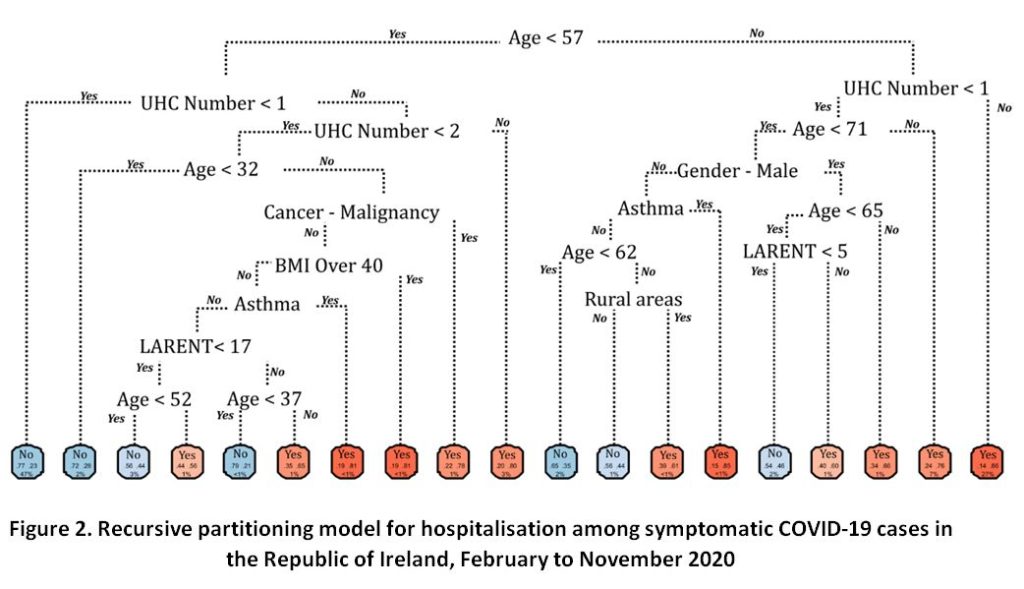The study of infectious disease represents a complex, multi-disciplinary, data-driven pursuit to better understand the patterns and drivers of these infections. In recent years, the role of the natural environment and socio-dynamics have added another lens through which to elucidate the epidemiology of disease. In the Republic of Ireland, diverse environmental conditions (i.e. geology, hydrology, meteorology etc.) and geospatially specific sources of contamination (septic tanks, agriculture, wastewater treatment plants) and susceptibility (urban Vs rural) pave the way for localized infection risks amongst the Irish populous. For example, over the past decade, Ireland has frequently reported the highest incidence rates of symptomatic verotoxigenic E. coli (VTEC) infection in the European Union (EU); the reported national incidence rate of confirmed STEC infections in Ireland during 2017 (16.6 cases/100,000 population; 923 cases), equated to approximately ten times the EU average (1.66 cases/100,000). The infection is characterised by several transmission routes, including consumption of contaminated food and water, person-to-person contact, or direct contact with infected animals, with a recent study by the authors indicating that the incidence of VTEC O157 (a particularly nasty E. coli serotype) infection was significantly elevated in Irish regions characterised by high private groundwater reliance (OR 18.727) and high livestock densities (OR 1.001).
To gain a holistic understanding of these patterns of disease across the country, the SpatioTemporal Environmental Epidemiology Research (STEER) group, led by Dr Paul Hynds (TU Dublin) and Dr Jean O’Dwyer (UCC), was established in 2018 to conduct advanced epidemiological research into the environmental, infrastructural, and social determinants of disease. The STEER group currently leads several projects ranging from infectious diseases due to contaminated groundwater (as mentioned above), to the effect of human mobility on COVID-19 to to the impact of climate change on human psychological health. For example, the EPA-funded DESIGN project is currently assessing groundwater contamination with both verotoxigenic E. coli (VTEC) and Cryptosporidium, both of which are frequently notified water-associated infections in the ROI. Results of this study are facilitating the development of spatially and temporally specific guidance to help protect the 750,000+ private well users in Ireland, translating field science into public health policy. Conversely, the IRC-funded EPI_CENTRE project and EPA-funded STEPWISE project are taking a different approach; through high resolution georeferencing of notified primary infectious disease (VTEC and Cryptosporidiosis), these projects focus on elucidating the socioeconomic and environmental drivers of infection, bridging the gap between our environment and our health. A recent STEER article has shown that numerous “hidden” space-time clusters of both VTEC enteritis and cryptosporidiosis occurred across Ireland during late spring 2016, and could be statistically associated with the hydrodynamics of a series of flood events which happened three to four months earlier in December 2015 (Figure 1), thus providing an insight into the complexity of these infections and their interaction with our natural environment.

More recently, in response to the ongoing pandemic, the STEER group is exploring the spatial distribution of COVID-19 in Ireland. Using fine resolution geo-referenced cases of both primary and secondary infection, the COSMID project aims to elucidate the occurrence and severity of infection relative to socioeconomic (e.g., occupation, unemployment) and infrastructural (e.g., urban/rural, distance to motorways) risk factors. To date, the project has provided crucial insights into the spread of the virus, with spatial disparities of infection noted, as well as socioeconomic inequalities (e.g., the link between socioeconomics, underlying health, and COVID-19 outcomes). For example, a developed series of prognostic (i.e., outcome) models for COVID-19 hospitalisation, ICU admission and mortality indicates that while patient age and underlying health are major predictors, socioeconomic profile (e.g., proportion of local population residing in Local Authority housing) and “place” (e.g., rurality) are also important factors driving COVID-19 outcomes (Figure 2).

While Ireland is characterised by a highly capable, highly qualified talent pool in the allied fields of medicine, immunology, biochemistry and computer science, there is little doubt that the COVID-19 pandemic has highlighted a critical absence with respect to the education, training, and subsequent presence of infectious disease modellers and epidemiologists in Ireland. Unfortunately, environmentally acquired infections like VTEC enteritis and cryptosporidiosis are here to stay, and many of us will likely encounter another pandemic in our lifetime. Accordingly, the study of infectious diseases has never been more crucial, necessitating a significant shift in our approach to epidemiological teaching and training. Public health emergency planning can only occur by increasing our epidemiological capacity and agility, not only in the numbers of graduates, funding opportunities and PhD students, but also the skills, approaches and areas they are trained in. If COVID-19 has thought us one thing, it is that we require many disciplines travelling in the same direction, including the inclusion of modelling, big data, programming, mapping, and socio-behavioural science under the increasingly large umbrella of infectious disease epidemiology.
The overarching goal of the STEER group and the wider epidemiological community is and must continue to be providing a robust evidence-base to guide policy, emergency planning and public health interventions, working towards a healthy environment and a healthy and safe Ireland.
 | Dr Paul Hynds is senior research fellow in the Environmental Sustainability and Health Institute (ESHI), Dublin Institute of Technology at Grangegorman, and participates in the iCRAG groundwater research spoke. He graduated with a PhD in Environmental Engineering in 2012 from Trinity College Dublin, with primary interests in environmental fate modelling, waterborne infection and statistical modelling. Dr Hynds currently works at the Environmental Sustainability and Health Institute, Dublin Institute of Technology. He does research in Epidemiology, Geostatistics, Environmental Infection and Hydrogeology. Current projects include the GSI-funded GRAppLE (Groundwater Risk Application for Local Evaluation), the GSI-funded ISO-MECH (Development of a groundwater isoscape for mechanistic recharge estimation and bacterial fingerprinting), the IRC-funded FloodRisk2WellWater and the GSI/iCRAG co-funded SMARTIE (Spatiotemporal multiscale Modelling of Antibiotic ResisTance in the Irish sub-surface Environment) project. |
 | Dr Jean O’Dwyer has a BSc in Environmental Science (2011) and a PhD in Environmental Health Science (2015) from the University of Limerick. Prior to joining UCC as a Lecturer in Environmental Science, she was an awarded IRC postdoctoral fellow and worked on several national (DAFM, Enterprise Ireland) and international (EU-FP7) research projects. Dr O’Dwyer currently leads the Environment and Health Research Lab, which hosts several funded projects assessing environmentally associated infectious diseases, groundwater quality, antimicrobial resistance and the impact of climate change on human health. She is a PI in the Environmental Research Institute and is Co-Lead of the Water and Environment Research Group. In 2020, Dr O’Dwyer was appointed as Head of Environmental Geosciences in the Irish Centre for Research in Applied Geosicences (iCRAG) which is funded by Science Foundation Ireland. |

